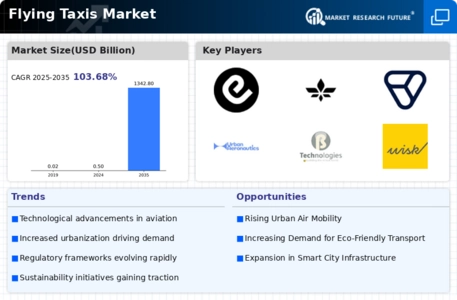Investment in Infrastructure
Investment in infrastructure is crucial for the growth of the Flying Taxis Market. Governments and private entities are increasingly recognizing the need to develop vertiports and air traffic management systems to support aerial mobility. According to recent estimates, investments in urban air mobility infrastructure could reach billions of dollars over the next decade. This financial commitment is likely to facilitate the integration of flying taxis into existing transportation frameworks, ensuring safety and efficiency. Furthermore, partnerships between aerospace companies and local governments may lead to the establishment of necessary regulatory frameworks, enhancing the operational viability of flying taxis. As infrastructure improves, the feasibility and attractiveness of flying taxis as a mode of transport will likely increase.
Changing Consumer Preferences
Changing consumer preferences are significantly influencing the Flying Taxis Market. As urban populations become more tech-savvy and accustomed to on-demand services, there is a growing appetite for innovative transportation solutions. Consumers are increasingly seeking convenience, speed, and flexibility in their travel options. Flying taxis, with their potential to offer rapid transit across congested urban areas, align well with these evolving preferences. Market Research Future indicates that a substantial portion of urban dwellers is open to using flying taxis for short-distance travel, particularly in metropolitan areas. This shift in consumer behavior may drive demand for flying taxi services, prompting companies to invest in developing user-friendly platforms and enhancing customer experiences. As consumer acceptance grows, the viability of flying taxis as a mainstream transportation option is likely to strengthen.
Urbanization and Population Growth
The rapid pace of urbanization and population growth is a key driver for the Flying Taxis Market. As cities expand and populations increase, traditional transportation systems face significant strain. This creates a pressing need for innovative solutions to alleviate congestion and improve mobility. The United Nations projects that by 2050, nearly 68 percent of the world's population will reside in urban areas, intensifying the demand for efficient aerial transport options. Flying taxis offer a potential solution by providing quick, direct routes that bypass ground traffic. This shift towards urban air mobility could reshape city landscapes and transportation networks, making flying taxis an attractive alternative for urban dwellers seeking convenience and efficiency.
Technological Innovations in Aviation
Technological innovations in aviation are propelling the Flying Taxis Market forward. Advances in electric propulsion, autonomous flight systems, and battery technology are making flying taxis more viable and efficient. For instance, electric vertical takeoff and landing (eVTOL) aircraft are being developed to reduce noise and emissions, addressing environmental concerns associated with traditional aviation. The market for eVTOL aircraft is projected to grow significantly, with estimates suggesting a value of over 1 trillion dollars by 2040. These innovations not only enhance the performance and safety of flying taxis but also contribute to their acceptance among consumers and regulatory bodies. As technology continues to evolve, the potential for flying taxis to become a mainstream transportation option appears increasingly plausible.
Environmental Sustainability Initiatives
Environmental sustainability initiatives are becoming a driving force in the Flying Taxis Market. As concerns about climate change and air pollution intensify, there is a growing emphasis on developing eco-friendly transportation solutions. Flying taxis, particularly those utilizing electric propulsion, present an opportunity to reduce carbon emissions and minimize the environmental impact of urban transport. Governments and organizations are setting ambitious targets for reducing greenhouse gas emissions, which may further incentivize the adoption of flying taxis. The potential for flying taxis to operate with lower noise levels and reduced emissions aligns with global sustainability goals, making them an appealing option for environmentally conscious consumers. This alignment with sustainability initiatives could enhance the market appeal of flying taxis, fostering broader acceptance and integration into urban transport systems.























Leave a Comment